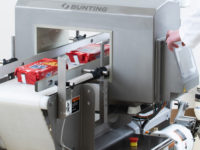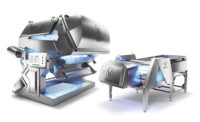Shipping contamination-free food products to the public has always been business-critical, but today’s social media landscape leaves virtually no room for error. A wider variety of products, along with a wide variety of packaging options, have increased the need for more flexible inspection and detection equipment. The good news: Manufacturers are answering the call with X-ray, metal detection, checkweighing and vision systems that help processors ensure food safety.
“New technology such as multiscan metal detection, which allows food processors to select up to five frequencies and identify contaminants that are up to 50 percent smaller, can overcome the limitations of previous solutions and improve food safety. This technology also is flexible, so it can change over time as the products being inspected evolve,” says Bob Ries, lead product manager, metal detection and X-ray inspection, Thermo Fisher Scientific, Waltham, MA.
View an Extended Slideshow featuring products listed in this article
X-ray inspection and metal detection are complementary technologies that improve the inspection and detection process and are best used in tandem. “In many cases, the best approach is to use metal detection early in the process, to screen out the most-common contaminants prior to adding value, and then place X-ray at the end of the line as the final critical control point looking for any type of dense foreign object, including metal,” Ries says.
X-ray machines allow operators to detect foreign objects or to see large gaps in packaging, while metal detectors alert operators to the presence of metals, explains Todd Grube, product manager, inspection systems, Heat and Control Inc., Hayward, CA. “One advantage of using X-ray inspection is its ability to find more than just metal; also, the performance is not affected by product signal. An exception is aluminum, a very low-density metal, where a metal detector often will outperform an X-ray machine. Another advantage for metal detection is the lower purchase price and cost of ownership over X-ray inspection.”
Progressive metal
Thermo Fisher Scientific recently introduced the Sentinel Multiscan Metal Detector, which addresses many of the challenges that snack and bakery plants have experienced with previous metal detection technology. The Sentinel is designed to run five metal detectors at once, which increases the probability of detection. Sensitivity is optimized and escapes disappear.
With its partner, CEIA, Heat and Control Inc. has introduced a multi-spectrum metal detector, the THS/MS21, with optional USDA-certified construction. It utilizes a broad spectrum of frequencies simultaneously. The technology eliminates false rejects caused by product effect without having to reduce metal detection sensitivity.
Bunting Magnetics, Newton, KS, offers imagePHASE recognition software for metal detection, which ensures better sensitivities for products that were once hard to detect, according to Barry Voorhees, metal detection product manager. The company recently rolled out autoTEST and tripleFREQUENCY upgrades to this software.
The autoTEST upgrade enables the testing of the sensitivity of a metal detector during operation without the use of personnel. Unlike the usual methods, in which test pieces have to be placed in the flow of product, autoTEST generates the field change by means of a signal coil.
The tripleFREQUENCY control option allows the processor to “learn” a product in three different frequencies. The metal detection system then selects the frequency that yields the greatest sensitivity for that particular product. With this upgrade, the detector also displays the expected sensitivities to all three metal types: ferrous, non-ferrous and stainless steel.
Fortress Technology, Oxfordshire, England, has unveiled the Interceptor DF (Divergent Field) multi-orientation, multiscan metal detector for food processors. It offers a 100 percent increase in sensitivity compared to single- or-dual frequency detectors and an improvement in identifying and rejecting contaminants that are non-spherical, according to Steve Gidman, president.
The Interceptor DF addresses previous limitations, including the orientation, size, geometry and position of metals, especially ultra-thin contaminants that might be more prevalent in high-value, low-profile foods such as snack bars, cookies and confectionery. “Rather than missing a metal contaminant because it hasn’t aligned with a specific frequency, the Interceptor DF uses multiple fields to inspect products as they pass through the detector. This increases the probability of finding a small shaving, or flake of metal, regardless of the orientation,” Gidman says.
X-ray vision
X-ray technology has matured and broadened its footprint in the snack and bakery industry. The advent of dual-energy inspection, such as Dual Energy X-Ray Absorptiometry (DEXA) technology from Eagle Product Inspection, Tampa, FL, expands the viability of the technology by helping manufacturers find inorganic materials in busy or chaotic images, notes Kyle Thomas, strategic business unit manager.
Also, low-energy X-ray systems have been developed that improve image processing capabilities. These machines feature fewer components in a more-compact design, which shrinks the machine footprint. They also are easier to clean and maintain.
Thanks to sensitive detectors and sophisticated algorithms, new X-ray machines meet safety requirements while providing robust levels of detection. “Also, the price gap between an X-ray machine and a metal detector has closed, so cost is no longer as great a factor,” says Tomasz Strzemecki, product manager, Loma Systems, an ITW Co., Carol Stream, IL.
“For example, the X5C Compact X-Ray from Loma is designed for convenience foods and goods in metalized packaging. The X5C detects all types of metal, as well as bone, glass and dense plastics. It has a small footprint and a simple, yet powerful, inspection feature set. So it is suitable for food processors who want to take the first step into using X-ray,” Strzemecki says.
Mettler Toledo, Tampa, FL, has introduced the X34 X-ray inspection system, which detects metal, glass, high-density plastic, mineral stone and calcified bone fragments across a wide range of packaged foods, including baked goods. Its software enables automated product setup, decreasing the chance of human error and reducing the number of false rejects.
The Ishida IX-GN Series X-ray inspection system from Heat and Control offers seven-step image analysis. Standard features include defect inspection, a masking feature that factors in individual product attributes that may cause false positives, and weight estimation. Ishida also offers the IX-EN Series X-ray inspection system, which provides reliable inspection for basic level applications with a lower-voltage X-ray tube.
Eagle Product Inspection has introduced the EPX100 X-ray machine, which can detect and reject contaminants such as glass shards, metal fragments, mineral stone, some plastic and rubber compounds, and calcified bones, in cartons, boxes, plastic containers and pouches. “It provides users with a 40 percent reduction in energy consumption versus a comparable legacy X-ray device,” Thomas says.
Additional options
Key Technology, Walla Walla, WA, introduced its VERYX digital sorters in 2015. Since then, the company has added new models in a variety of sizes to meet a wide range of applications. To further improve detection accuracy, the company recently unveiled Pixel Fusion, which combines pixel-level input from multiple cameras and laser sensors to differentiate foreign material (FM) and defects from good product. “Equipping VERYX with our optional FMAlert software adds another layer of protection. FMAlert captures and saves digital images of contaminants and can be programmed to immediately alert operators and signal a downstream device during critical FM events,” says John Kadinger, marketing manager.
Yamato Corp., Mequon, WI, specializes in checkweighers for snack and bakery plants. To alleviate space issues, the company offers a combination machine in which a metal detector is installed on a checkweigher infeed conveyor. A three-way reject (accept, metal and weight) is installed to support these combination systems. Additional devices can be installed to reject specific over/underweights or to reject based on another inspection step in the packing line. “With checkweighers, weighing at high speeds has come a long way. Often, it is not the weight measurements that slow down the line; instead the reject devices are the bottlenecks. Creative reject solutions have to be designed and developed to support the high line speeds,” says James Lubow, product manager.
What technological advances in inspection/detection do experts see happening in the near future?
One trend is the consolidation of separate inspection methods into combination systems, says Sarrina Crowley, marketing manager, Mettler Toledo. “For example, Mettler Toledo offers configurations that combine into one system a metal detector with X-ray inspection and a metal detector with a vision system. In the future, even more systems will be combined into one unit, saving valuable line space and reducing power requirements.”






